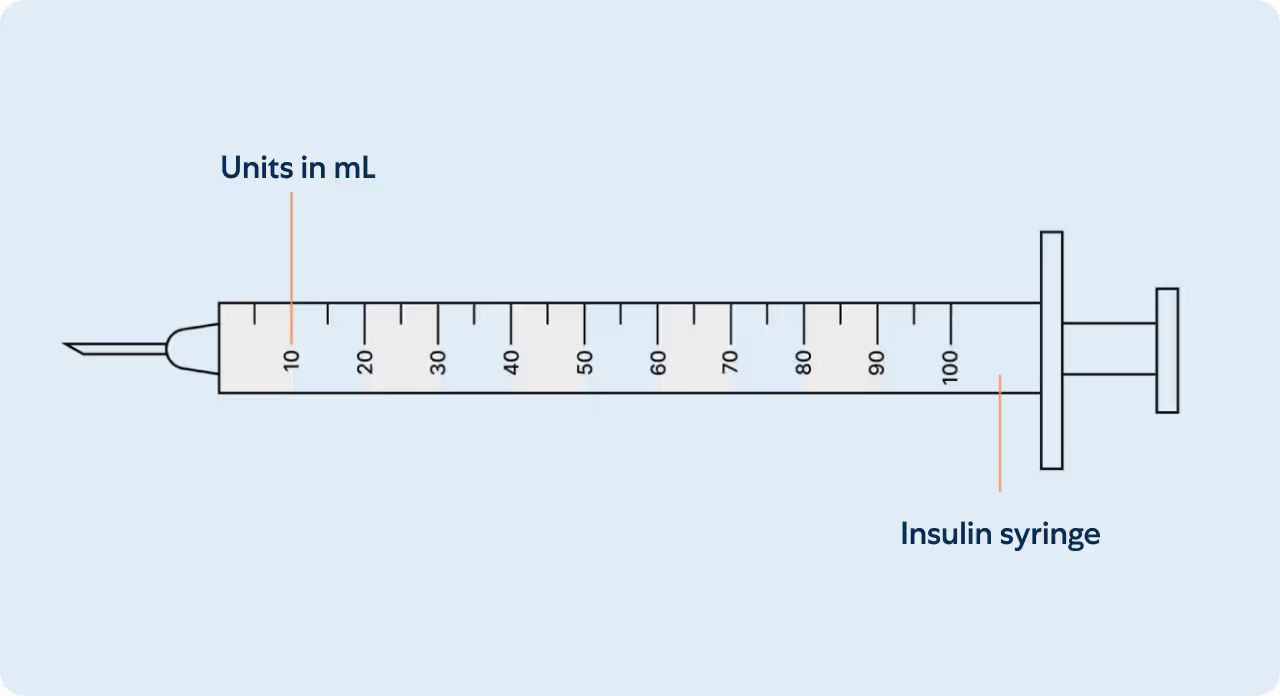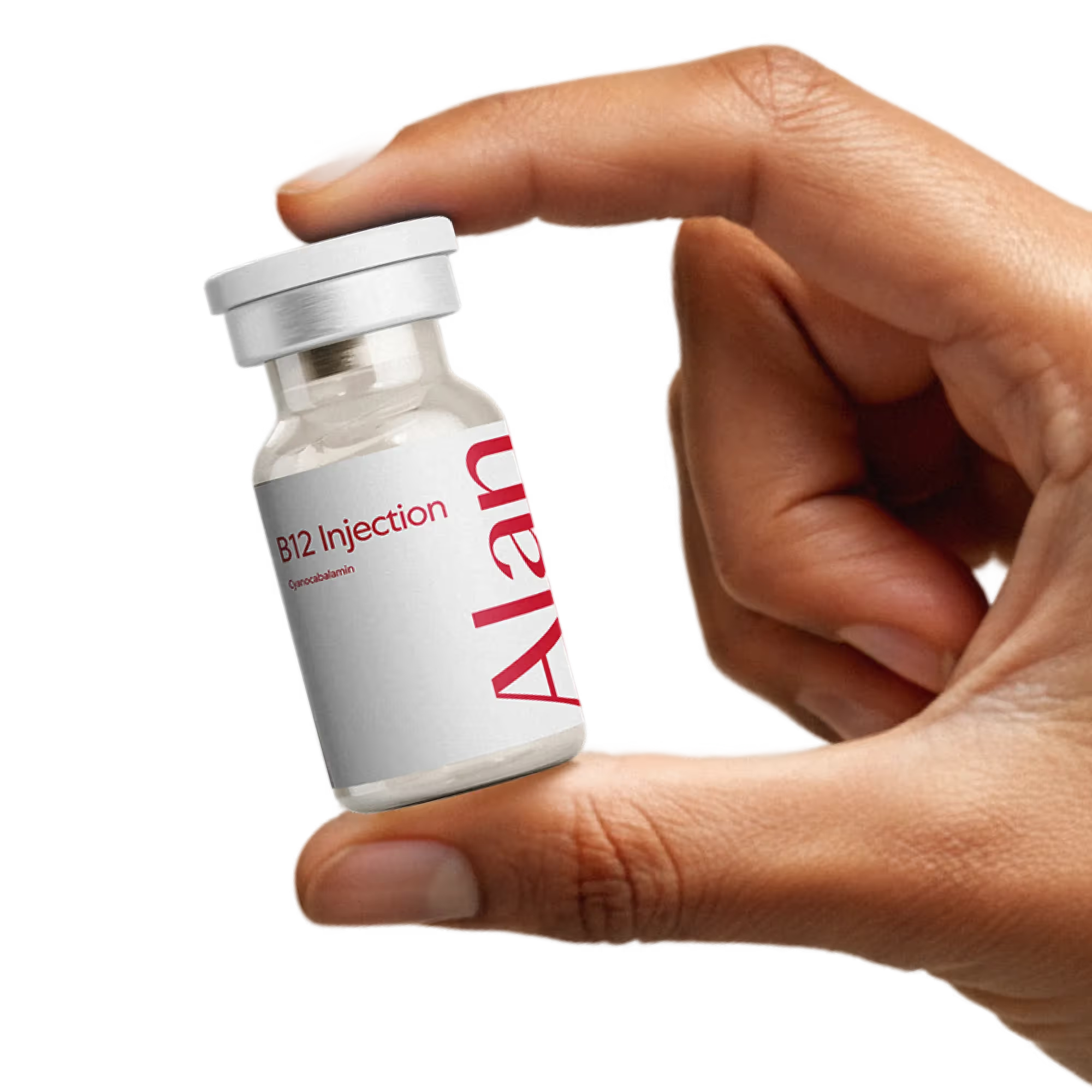Storage
Always refrigerate your vial at 36–46 °F (2–8 °C), never freeze it, and avoid storing it next to the cooling element. Protect your vials from direct sunlight and heat.
Instructions
This information is intended for individuals who have been prescribed B12 Cyanocobalamin Injections by their Alan Health provider.
Inject once weekly as directed by your healthcare provider using a vial and syringe.
{{injection-video}}
Clean the injection site, insert the needle at a 45–90-degree angle, and inject the medication slowly. Hold until fully administered. Rotate injection sites daily to avoid irritation.
- Prep Your Supplies: Wash hands and gather the B12 cyanocobalamin vial, insulin syringe, alcohol swabs, and a sharps container. Inspect the solution—it should be clear and free of particles.
- Draw the Dose: Clean the rubber top of the vial with an alcohol swab. Inject air into the vial equal to your prescribed dose, then draw up the exact amount. Remove any air bubbles by tapping the syringe and pushing gently on the plunger.
- Pick an Injection Site: Use the abdomen (at least 2 inches from the belly button), thigh, or upper arm. Clean the area with an alcohol swab and allow it to dry completely.
- Inject: Gently pinch the skin. Insert the needle at a 45–90° angle, depending on needle length and body type. Inject the medication slowly and steadily. Once done, remove the needle and apply gentle pressure with a clean swab. Dispose of the syringe safely in a sharps container.
If your medication has a seal, watch this video to learn how to remove it.
To learn how to inject your medication subcutaneously, please watch this video.
Missed Dose? If you miss a dose, skip the missed dose and continue with your regular schedule. If you have any questions about your dosing schedule, contact your Alan Health provider.
Understanding your insulin syringe

Measuring your dose
Insulin syringes are used for subcutaneous injections. They are marked in Units on the insulin syringe barrel (see illustration). Insulin syringes facilitate the precise measurement of tiny amounts of liquids which are ideal for medications such as insulin that require small and accurate dosing. Unit marks are also expressed in mL’s and can be interchangeably referenced. A prescriber may write a prescription in Units or in mL’s.
Within the amount of liquid is the prescribed mg dosage of your medication (see mg chart). Milligrams (mg) is not an amount of liquid, but rather the amount of drug that is within. The conversion between units and milligrams varies depending on the concentration of the product being used.
What can I expect?
Safety information
The most common side effects of cyanocobalamin injections include mild injection site reactions (such as redness or soreness), headache, nausea, and diarrhea.
In rare cases, side effects may include allergic reactions, swelling, chest tightness, or difficulty breathing. Seek immediate medical attention if you experience any of these symptoms.
A full list of side effects can be found here.
Do not use this product if you are currently pregnant, breastfeeding, or plan to become pregnant or breastfeed without consulting a qualified healthcare provider.
If you or a family member has a history of Leber’s Optic Neuropathy, do not take B12, as it may cause permanent vision loss. Instead, notify us and consult your local physician in person.
Note: The above statements have not been evaluated by the Food and Drug Administration. This product is not intended to diagnose, treat, cure, or prevent any disease.
Frequently Asked Questions
What is Vitamin B12 and why is it important?
Vitamin B12 is an essential nutrient that helps your body produce energy, maintain brain health, and form red blood cells. Without enough B12, you may experience fatigue, brain fog, low mood, or even anemia.
How quickly will I feel the effects?
Many people notice an improvement in energy and mental clarity within a few days of their first injection. For others, it may take a few weeks of consistent use. Results can vary depending on individual B12 levels and overall health.
What is the difference between cyanocobalamin and methylcobalamin?
Cyanocobalamin is a stable, lab-made form of B12 that your body converts into its active form. It is cost-effective and effective for treating common B12 deficiencies. Methylcobalamin is a naturally occurring form that may offer added benefits for those with severe deficiencies or neurological symptoms.
Is Vitamin B12 safe for long-term use?
Yes. B12 is water-soluble, meaning your body excretes any excess through urine. Regular use is generally safe, but your healthcare provider may recommend monitoring your levels over time.
Why choose a B12 injection over an oral supplement?
Injectable B12 delivers the vitamin directly into your bloodstream, bypassing the digestive system. This ensures better absorption, particularly for people with gastrointestinal conditions or difficulty absorbing nutrients from food.
What is the recommended dosage per injection?
Each injection contains 1,000 mcg (1 mL) of cyanocobalamin. Always follow the dosage instructions provided by your healthcare provider.
How often do I need to administer the B12 injection?
Typically, B12 injections are administered once a week. However, your provider may adjust the frequency based on your specific needs and B12 levels.
Are there any side effects associated with B12 injections?
B12 injections are generally well tolerated. Some people may experience mild redness, swelling, or discomfort at the injection site. Uncommon side effects should be discussed with your provider.
How should I store my B12 injection vials?
Store the vials at room temperature; keep vials away from light and do not freeze. Always check the expiration date before use.
Additional support
For details about your medication and dosing, please log in to your patient portal. Your physician is here to help with any medical questions. If you are experiencing a medical emergency, call 911 right away.













